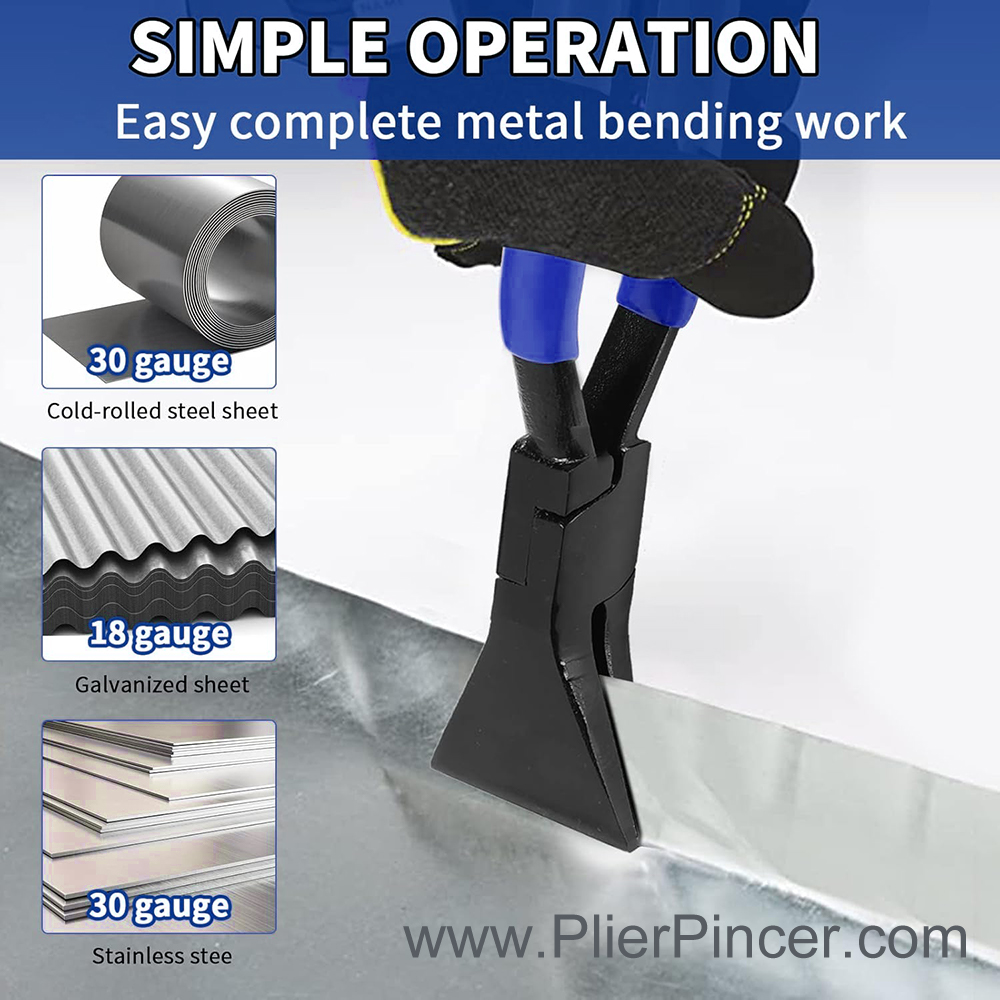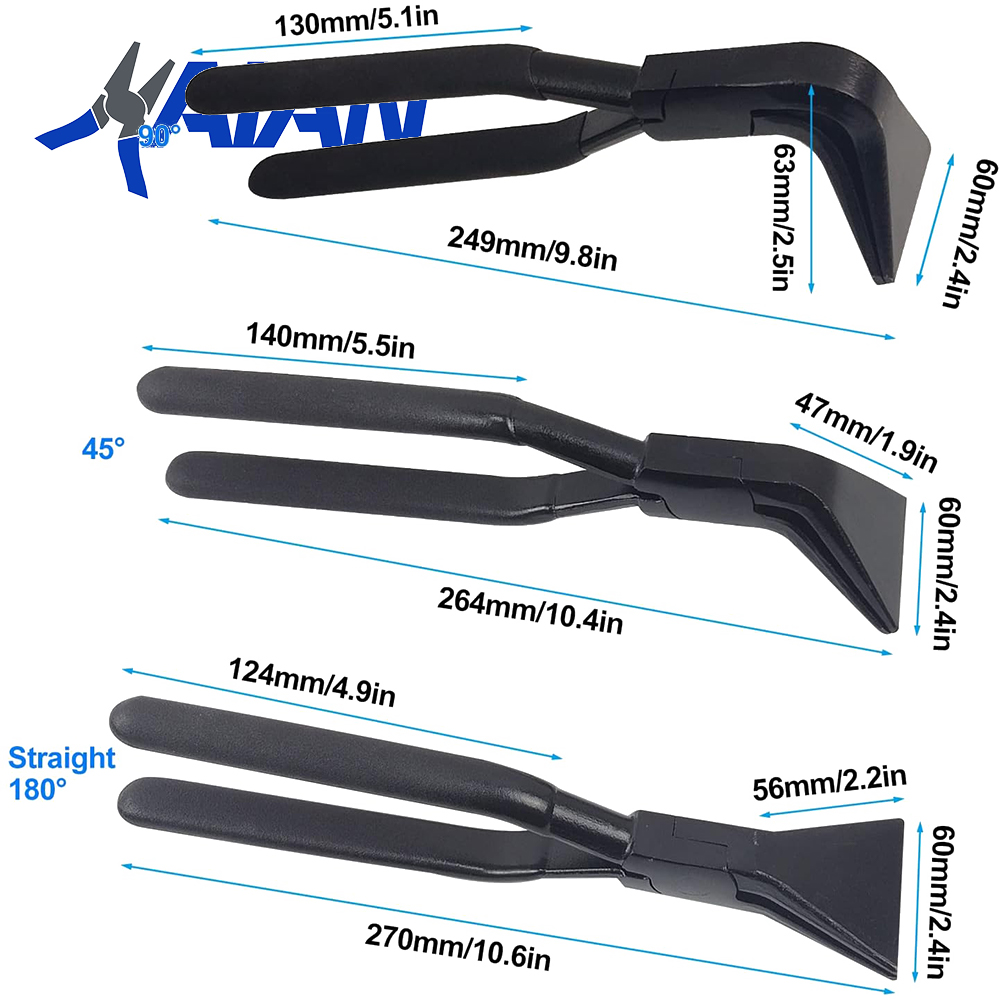
Sheet metal bending pliers are a type of sheet metal pliers for bending and shaping sheet metal. They go hand in hand with tin snips or aviation snips.
Bending pliers look like regular pliers with wide flat-blade jaws for gripping and manipulating metal sheets.
Other names for sheet metal bending pliers are hand seamers, sheet metal hand brake, or Fairmont tongs. Sheet metal workers just call them tongs because they often use them to safely grip and move metal sheets around the job site.
Some people, however, think that hand seamers are the same thing as sheet metal brakes. Hence use the names interchangeably. That’s not true although both of them are types of sheet metal bending tools.
A sheet metal brake is a large tool for making longer-run bends whilst hand seamer pliers bend metal in small increments. Moreso, sheet metal brakes are like a workbench whereas a hand seamer is just a hand tool or a type of pliers for shaping sheet metal.
Hand seamer pliers are good for bending small sheet metals into desired shapes. They are a must-have where detail is needed in forming metal.
Hand seamer uses

As I have mentioned, hand seamers have multiple uses including bending, folding, flattening, straightening, gripping, and pulling sheet material. They can be used in any trade or project that involves sheet metal work.
Most applications of sheet metal seamers are in HVACR installation, roofing, siding applications, hemming, remodeling, and shaping flanges. Even flooring. You can use them as tongs to grab flooring sheets.
In the RV building industry, sheet metal bending pliers are the second most important pliers for sheet metal after tin snips. RV manufacturers use them to bend and shape aluminum siding.
HVAC technicians use hand seamers quite often in sheet metal ductwork to bend square ducts, make lips on plenum boxes, and hem sharp edges.
Sheet metal roofing is also another application where fairmont tongs find tons of uses. Roofers use them to manipulate, hem, grip, or safely pull roofing sheets. They also use them to bend and shape rain gutters.
How to use sheet metal bending pliers
The following are steps for using sheet metal bending pliers.
Step 1: Select the appropriate sheet metal bending pliers
Hand seamers come in different sizes for various sheet metal gauges. Make sure you select the appropriate hand seamer for the sheet metal gauge you will be working with.
Step 2: Prepare the workspace
Set the metal sheet on the work table. Clear the table so that you have enough working space.
Step 3: Set the bending depth
The bending depth refers to how deep the pliers go into the metal before making a bend. It is measured from the edge of the material.
You can bend sheet metal at different depths depending on your project. However, most hand seamers can only bend metal between 1/4″ and 1-1/4″ from the edge.
Some seamers even have seam depths marked on the jaws. This helps in setting the depth of bend more accurately and faster. You do not need to mark the metal sheet before bending it.
Seam depth markings or notches on the jaw are one of the important features to look for when buying hand seamers. They enable you to make precise bends without using a tape measure
Step 4: Bend the sheet metal
Clamp the sheet metal at the correct depth and leverage the pliers against the workbench to bend the metal upwards.
If the length of the sheet metal is wider than the width of the jaws, start making the bend from the center. Then bend the rest of the length in small increments
However, it is best to use hand seamer pliers to bend sheet metal pieces with lengths that are not wider than the jaws. This produces the most accurate bends.
Ideally, a sheet metal brake is suitable for making bends that run long.
Step 5: Inspect the sheet metal bend angle to ensure it is correct
Check to see if the bend is correct and at the desired angle. The typical angle of bend is 90 degrees but some sheet metal projects will require you to bend the metal more or less. It depends on the needs of your project.
You can use a speed square to measure the angle or estimate by mere observation. The choice is yours.
Buying Guide for Best Sheet Metal Bending Pliers
There are so many features to look for when shopping for sheet metal forming pliers but these are the most important ones.
1) Comfortable handles
Hand seamers or sheet metal tongs require a firm hand squeeze on the handles to grip the stock firmly. As such, your hand is bound to get a beating if the handles are not comfortable enough.
Good sheet metal bending pliers should have soft ergonomic handles that are comfortable and easy on the hands. The soft contoured grips do it for me all the time.
2) Locking feature
The locking mechanism on a hand seamer locks the jaws onto the stock so that you can focus your effort on bending and manipulating the metal. It also provides good leverage, especially when forming heavy-duty panels.
3) Calibrated jaws
Jaws that have the seaming depth scale marked make it easy to bend sheet metal accurately. You don’t have to pre-mark the stock. Just set the stock to the right seaming depth and you are good to go.
Some bending pliers scales stamped on the jaws in inches while others notched at equal increments (typically 1/4″). Whatever the case, sheet metal pliers with calibrated jaws make sheet metal forming so much easier. It is the most important feature I look for.
4) Jaw width

Although you can use hand seamers to bend long sheet metal pieces in small increments, you get the best results when the length of the metal is not wider than the width of the jaws.
So choose sheet metal seamers with a jawline that is larger or equal to the length of stock you will be bending.
If budget allows, you can get a few bending pliers with different jaw lengths. The two common hand seamer jaw widths are 3 inches and 6 inches.
5) Jaw depth
Like jaw width, sheet metal forming pliers come with different jaw depths. Jaw depth or throat depth is the length of the jaw from the tip to the back of the jaw. It is also known as seaming depth.
The seaming depth of a hand seamer determines the maximum length of sheet material you can bend from the edge.
It is good to make sure your seamers have sufficient bending depth for your sheet metal works. To be safe, get the seamers with the most depth so that you can use them to bend a wider range of lengths.
Conclusion
Sheet metal bending pliers or hand seamers are must-have tools for bending and forming sheet metal. They beat bending metal with vise grips and hammer, hand, or teeth. You can even use them to pinch the hems you make with a folding bar . You only need to get the right set for the job.